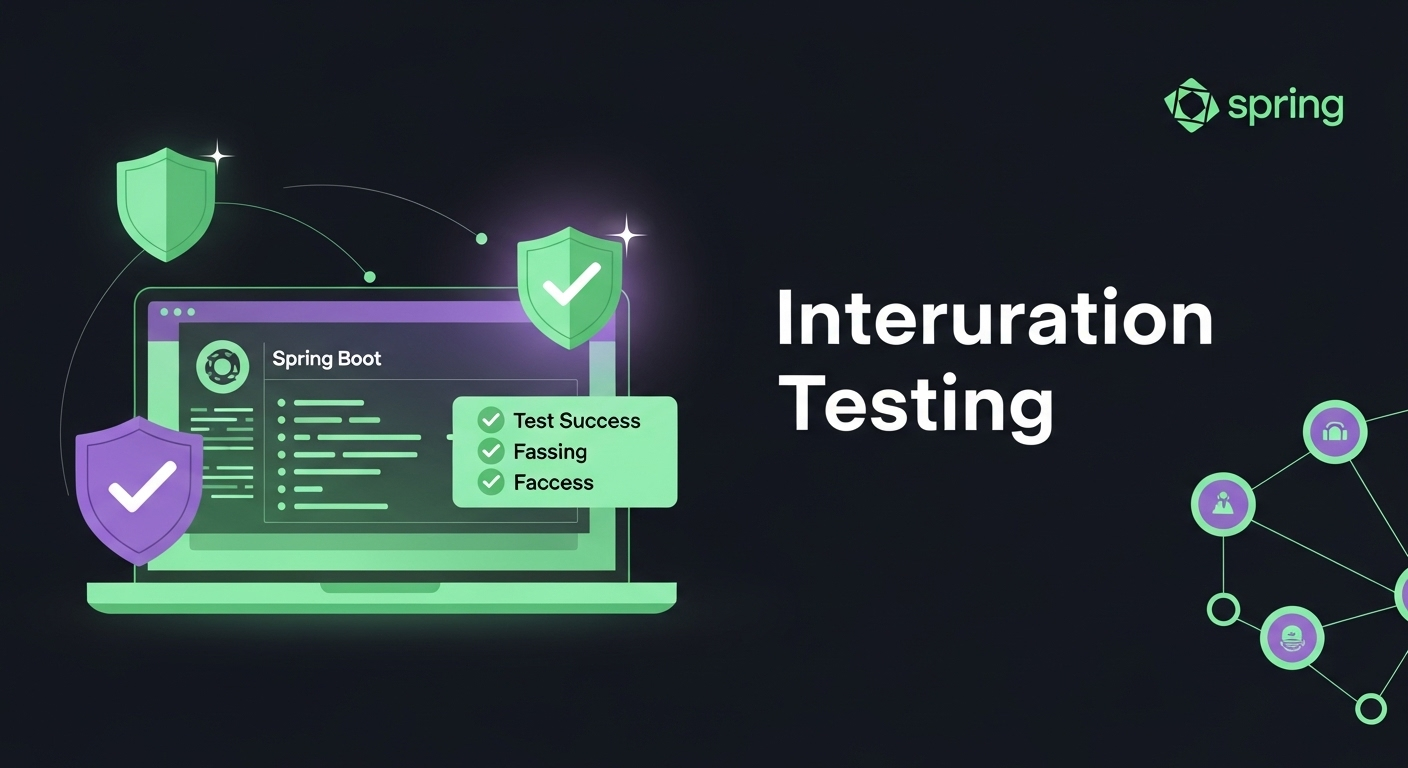Spring Boot Integration Testing - ඔබේ App එකට පූර්ණ විශ්වාසයක් SC Guide

Spring Boot Integration Testing: ඔබේ App එකට පූර්ණ විශ්වාසයක්!
ආයුබෝවන්, මගේ developer යාලුවනේ! 🚀
අද අපි කතා කරන්න යන්නේ Software Engineering වල ගොඩක් වැදගත්, ඒ වගේම ටිකක් සංකීර්ණ වගේ පෙනුනත්, ඇත්තටම අපේ Project එකකට ලොකු හයියක් වෙන Topic එකක් ගැන – ඒ තමයි Integration Testing. අපි හැමෝම දන්නවා Unit Tests කියන්නේ මොනවද කියලා. අපේ code එකේ තියෙන පොඩි පොඩි කොටස් (units) තනියෙන් හරියට වැඩ කරනවද කියලා බලන්න ඒවා ගොඩක් වැදගත්. හැබැයි, ඒ පොඩි පොඩි කොටස් ටික එකට එකතු වුනාම හරියට වැඩ කරයිද? 🤨 Database එකත් එක්ක, external services එක්ක, messaging queues එක්ක අපේ application එකේ components හරියට ගැලපිලා වැඩ කරයිද? අන්න ඒ ප්රශ්නයට උත්තරේ තමයි Integration Testing කියන්නේ.
අද අපි බලමු Spring Boot Application එකක Integration Tests ලියන්නේ කොහොමද, ඒකට `@SpringBootTest` වගේ annotations කොච්චර උදව් වෙනවද, වගේම මේකෙන් අපේ Project එකට ලැබෙන වාසි මොනවද කියලා. එහෙනම්, අපි පටන් ගමු!
1. Integration Testing කියන්නේ මොකක්ද? (Integration Testing Explained)
සරලවම කිව්වොත්, Integration Testing කියන්නේ අපේ software system එකේ විවිධ modules හෝ components එකිනෙකත් එක්ක හරියට “ගැලපිලා” වැඩ කරනවද කියලා බලන ක්රමයක්. Unit Testing වලදී අපි බලන්නේ individual units (තනි functions, methods) හරියට වැඩ කරනවද කියලනේ. හැබැයි Integration Testing වලදී අපි බලන්නේ ඒ units කිහිපයක් එකට එකතු වෙලා හදන module එකක්, නැත්නම් system එකේ කොටසක් හරියට වැඩ කරනවද කියන එක.
උදාහරණයක් විදිහට, ඔයා Online Shopping Cart එකක් හදනවා කියමු. Customer කෙනෙක් Product එකක් Cart එකට add කරනවා. මේකෙදි වෙන්නේ:
- Cart Controller එකට request එකක් එනවා.
- Service Layer එකෙන් Product එක validate කරලා, Database එකට Cart Item එක add කරනවා.
- ඒ update එක හරියට වෙලා, Total Price එක calculate කරනවා.
මේ process එකේදී Controller, Service, Repository, Database කියන layers කීපයක් එකිනෙකට සම්බන්ධ වෙනවා. මේ හැමදේම එකට හරියට වැඩ කරනවද කියලා බලන එක තමයි Integration Test එකකින් කරන්නේ. ඒ කියන්නේ, මේක Unit Test එකකට වඩා Real-World Scenario එකකට ලං වෙන්න Test කරන ක්රමයක්.
2. ඇයි Integration Testing වැදගත් වෙන්නේ? (Why Integration Testing Matters)
ඔයා හිතනවා ඇති, “අනේ මේ, Unit Tests දාලා ඉවර වුණාම ඒ ඇතිනේ!” කියලා. ඒත් එහෙම නෑ යාලුවනේ. Integration Tests නැතුව Project එකක් Production එකට දානවා කියන්නේ, අපි කොහේ යනවද කියලා නොදැන Driving කරනවා වගේ වැඩක්. මේවායින් අපිට ලැබෙන වාසි ගොඩක් තියෙනවා:
- Real-world Scenario Testing: Unit Tests වලදී අපි Mock Objects පාවිච්චි කරනවානේ. ඒ කියන්නේ Database, External API වලට යන calls ඇත්තටම යන්නේ නෑ. Mock කරනවා විතරයි. හැබැයි Integration Tests වලදී අපි ඇත්තටම ඒ Layers එක්ක communicate කරනවා. ඒ නිසා අපේ App එක Production එකේදී වැඩ කරන විදිහටම Test කරන්න පුළුවන්.
- Finding Interface Bugs: අපි ලියපු Components අතර Communication Problems තියෙනවා නම්, ඒ කියන්නේ එක Component එකක් තව එකකට වැරදි data set එකක් දෙනවා නම්, නැත්නම් වැරදි format එකකින් data යවනවා නම්, ඒවා අල්ලගන්න Integration Tests වලින් පුළුවන්. මේවා Unit Tests වලින් අල්ලගන්න අමාරුයි.
- Confidence in the System: ඔයාගේ App එකේ හැමදෙයක්ම එකට වැඩ කරනවා කියලා දැනගන්න එකෙන් ලැබෙන Confidence එක ලොකුයි. “අනේ මලක් වගේ!” කියලා, කිසිම බයක් නැතුව Project එක Deploy කරන්න පුළුවන් වෙන්නේ හොඳට Tests කරලා තියෙනවා නම් තමයි.
- Reduced Production Bugs: මුලින්ම Bugs අල්ලගන්න එකෙන්, Production එකට ගියාට පස්සේ එන Issues ගාණ ගොඩක් අඩු වෙනවා. Production එකේ Bug එකක් ආවොත් ඒක Fix කරනවා කියන්නේ කාලයත්, මුදලත් නාස්ති වීමක්.
3. Spring Boot එක්ක Integration Tests ලියමු! (@SpringBootTest Magic)
Spring Boot වලින් Integration Tests ලියන එක “අනේ මලක් වගේ” ලේසියි! ඒකට ප්රධානම හේතුව තමයි Spring Boot Framework එක Test කරන්න අවශ්ය environment එක අපිට Autoconfigure කරලා දෙන එක. මෙතනදී ප්රධානම Annotation එක තමයි @SpringBootTest.
@SpringBootTest Annotation එකේ බලය:
ඔයා Test Class එකක් උඩට @SpringBootTest කියලා දැම්මම මොකද වෙන්නේ? Spring Boot App එකේ whole application context එක load කරනවා. ඒ කියන්නේ, ඔයාගේ Controller, Service, Repository layers ඔක්කොම Actual Beans විදිහට load වෙනවා. එතකොට අපිට පුළුවන් ඒවා Direct Inject කරලා Test කරන්න, හරියට App එක Run වෙනකොට වගේම.
අපි සරල REST API එකක් උදාහරණයක් විදිහට ගමු. Product details manage කරන්න ProductController එකක් තියෙනවා කියලා හිතමු.
// ProductController.java
@RestController
@RequestMapping("/products")
public class ProductController {
private final ProductService productService;
public ProductController(ProductService productService) {
this.productService = productService;
}
@GetMapping
public ResponseEntity<List<Product>> getAllProducts() {
List<Product> products = productService.findAllProducts();
return ResponseEntity.ok(products);
}
@PostMapping
public ResponseEntity<Product> createProduct(@RequestBody Product product) {
Product createdProduct = productService.saveProduct(product);
return ResponseEntity.status(HttpStatus.CREATED).body(createdProduct);
}
}
දැන් මේක Test කරන්න Integration Test එකක් ලියමු.
// ProductControllerIntegrationTest.java
import org.junit.jupiter.api.Test;
import org.springframework.beans.factory.annotation.Autowired;
import org.springframework.boot.test.autoconfigure.web.servlet.AutoConfigureMockMvc;
import org.springframework.boot.test.context.SpringBootTest;
import org.springframework.http.MediaType;
import org.springframework.test.web.servlet.MockMvc;
import org.springframework.test.web.servlet.request.MockMvcRequestBuilders;
import org.springframework.test.web.servlet.result.MockMvcResultMatchers;
import static org.springframework.test.web.servlet.result.MockMvcResultHandlers.print;
@SpringBootTest
@AutoConfigureMockMvc // MockMvc auto-configuration
public class ProductControllerIntegrationTest {
@Autowired
private MockMvc mockMvc;
// Test for GET /products endpoint
@Test
void getAllProducts_shouldReturnAllProducts() throws Exception {
mockMvc.perform(MockMvcRequestBuilders.get("/products"))
.andDo(print())
.andExpect(MockMvcResultMatchers.status().isOk())
.andExpect(MockMvcResultMatchers.content().contentType(MediaType.APPLICATION_JSON));
// You can add more specific assertions, e.g., check for expected data
}
// Test for POST /products endpoint
@Test
void createProduct_shouldCreateNewProduct() throws Exception {
String productJson = "{\"name\":\"Test Product\", \"price\":100.0}";
mockMvc.perform(MockMvcRequestBuilders.post("/products")
.contentType(MediaType.APPLICATION_JSON)
.content(productJson))
.andDo(print())
.andExpect(MockMvcResultMatchers.status().isCreated())
.andExpect(MockMvcResultMatchers.jsonPath("$.name").value("Test Product"));
}
}
මේ Code එකේ තියෙන වැදගත් දේවල්:
@SpringBootTest: මේක අපේ application context එක load කරනවා. ඒ නිසා අපේ Controller, Service, Repository layers ඔක්කොම actual beans විදිහට inject වෙනවා.@AutoConfigureMockMvc: මේකෙන් අපිටMockMvcobject එකක් inject කරගන්න පුළුවන්.MockMvcකියන්නේ HTTP requests simulate කරන්න පුළුවන් utility එකක්. ඒ කියන්නේ අපිට ඇත්තටම HTTP request එකක් යවන්නේ නැතුව, Spring MVC infrastructure එක ඇතුළෙන්ම request එකක් Run කරලා බලන්න පුළුවන්. මේකෙන් Tests වේගවත් වෙනවා, ඒ වගේම real HTTP server එකක් Run කරන්න අවශ්ය වෙන්නෙත් නෑ.mockMvc.perform(...): මේකෙන් තමයි අපි request එක simulate කරන්නේ.get(),post()වගේ methods පාවිච්චි කරලා HTTP method එක specify කරන්න පුළුවන්.andExpect(...): මේකෙන් අපිට ලැබෙන response එකේ status code එක, content type එක, JSON path වල values වගේ දේවල් Assert කරන්න පුළුවන්. (උදා:.isOk(),.isCreated(),.jsonPath("$.name").value("Test Product"))
Database Testing:
@SpringBootTest එකෙන් whole application context එක load වෙන නිසා, ඔයාගේ application එක configure කරලා තියෙන actual database එකම test එකටත් පාවිච්චි වෙනවා. මේක හොඳයි Real-World Scenario එකට ලං වෙන්න. හැබැයි මේකේ Risk එකක් තියෙනවා – ඒ තමයි Actual Database එකේ Data වෙනස් වෙන්න පුළුවන් Test Run කරනකොට.
ඒකට විසඳුමක් විදිහට:
- In-memory Databases (H2): Test Profiles පාවිච්චි කරලා Test Environment එකට විතරක් H2 වගේ in-memory database එකක් configure කරන්න පුළුවන්. මේකෙන් Tests ඉක්මන් වෙනවා වගේම, Actual Database එකට හානියක් වෙන්නෙත් නෑ.
- Testcontainers: මේක අලුත්ම trend එකක්. Docker container එකක් ඇතුළේ Actual Database එකක් (PostgreSQL, MySQL වගේ) Run කරලා Test කරන්න පුළුවන්. මේකෙන් Real-World Database එකක හැසිරීම හරියටම Simulate කරන්න පුළුවන්, ඒ වගේම Test එක ඉවර වුනාම Container එක Clean වෙන නිසා Data Contamination වෙන්නෙත් නෑ.
- @Transactional: Spring Test Framework එකේදී Tests run කරනකොට Transaction එකක් ඇතුළේ run කරන්න පුළුවන්.
@Transactionalannotation එක Test method එකට උඩින් දැම්මොත්, Test එක ඉවර වුනාම ඒ Transaction එක Rollback වෙනවා. ඒ කියන්නේ Test එකෙන් Database එකට කරපු changes revert වෙනවා. මේක Database state එක Cleanව තියාගන්න හොඳ ක්රමයක්.
4. ප්රයෝගික උපදෙස් සහ Best Practices (Practical Tips & Best Practices)
Integration Tests ලියනකොට අපේ Project එක Speed-Up කරගන්නත්, Maintain කරගන්නත් උදව් වෙන Tips ටිකක් මෙන්න:
- Keep it Focused (Slice Testing): හැම Test එකක්ම මුළු App එකම load කරන්න ඕනේ නෑ. සමහර වෙලාවට අපිට අවශ්ය වෙන්නේ Data Access Layer එක විතරක් Test කරන්න වෙන්න පුළුවන්. එතකොට
@DataJpaTestවගේ Spring Boot Slice Tests පාවිච්චි කරන්න පුළුවන්. මේවා@SpringBootTestඑකට වඩා වේගවත්, මොකද ඒවයින් load වෙන්නේ application context එකේ පොඩි කොටසක් විතරයි. - Test Profiles Use කරන්න: Test එකට විතරක් වෙන configuration (e.g., in-memory DB settings) දෙන්න
src/test/resources/application-test.propertiesවගේ Test Profile එකක් හදන්න. එතකොට Production එකේ Configuration එකට හානියක් වෙන්නේ නෑ. - Data Setup and Cleanup: Test එකක් Run කරනකොට ඒකට අවශ්ය Data Database එකට Load කරන්නත්, Test එක ඉවර වුනාම ඒ Data Clean කරන්නත් පුරුදු වෙන්න. JUnit 5 වල නම්
@BeforeEach,@AfterEach(or JUnit 4@Before,@After) වගේ Annotations පාවිච්චි කරන්න.@Transactionalගැනත් කලින් කිව්වනේ. ඒක හොඳ විසඳුමක්. - Speed is Key: Integration Tests Unit Tests වලට වඩා Slow වෙන්න පුළුවන්. ඒ නිසා:
- In-memory databases (H2) or Testcontainers පාවිච්චි කරන්න.
- CI/CD pipelines වලදී Parallel Execution ගැන අවධානය යොමු කරන්න.
- හැමදේම Integration Test කරන්න යන්න එපා. Unit Tests වලින් Cover කරන්න පුළුවන් දේවල් Unit Test කරන්න. Integration Tests දාන්නේ Complex Interactions වලට විතරයි.
- Realistic Data: Real-world scenarios වලදී එන්න පුළුවන් data patterns වලට අනුකූලව Test Data හදන්න. Edge cases, invalid inputs වගේ දේවලුත් Test කරන්න අමතක කරන්න එපා.
නිගමනය (Conclusion)
ඉතින් යාලුවනේ, ඔයාලට තේරෙන්න ඇති නේද Integration Testing කියන්නේ නිකම්ම code test කරන එකක් නෙවෙයි, අපේ System එක ගැන පූර්ණ විශ්වාසයක් build කරගන්න පුරෝගාමී පියවරක් කියලා. විශේෂයෙන් Spring Boot වගේ Powerful Framework එකක් එක්ක නම් මේක “අනේ පට්ට වැඩක්!”. මේකෙන් අපේ Code Quality එක වැඩි දියුණු වෙනවා වගේම, Bugs අඩු වෙලා Customers ලට Stable Application එකක් දෙන්නත් පුළුවන් වෙනවා.
දැන් ඉතින් ඔයාලගේ Project එකකට @SpringBootTest දාලා Integration Test එකක් ලියලා බලන්න. පොඩි Sample App එකක් හදලා Test කරලා බලන්න. මේ concepts ප්රැක්ටිකල්ව කරලා බලන එකෙන් තමයි හොඳටම ඉගෙන ගන්න පුළුවන් වෙන්නේ.
ප්රශ්න තියෙනවා නම්, Comment Section එකේ අහන්න. අපි බලමු ඔයාලට උදව් කරන්න පුලුවන්ද කියලා. තව මොන වගේ Topics ගැනද කතා කරන්න ඕනේ කියලා Comment එකක් දාගෙන යන්න!
ආයෙත් හම්බවෙමු! Happy Coding! ❤️



